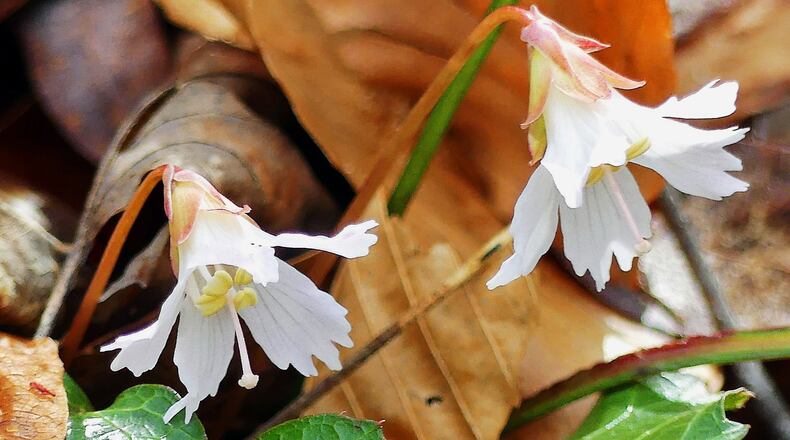The Oconee bell is one of the South’s most strikingly beautiful wildflowers in early spring — and one of its rarest, found in the wild only along a few shady streams in the Appalachian foothills of Georgia and the Carolinas.
Its discovery in 1787, loss and rediscovery are one of the most fascinating tales in botany. The plant has inspired numerous scientific papers, magazine articles, books and even a song.
It also was what drew several of us Georgia Botanical Society members last weekend to Devil’s Fork State Park on the shore of Lake Joccasee in upstate South Carolina, which harbors one of the largest populations of the showy wildflower. We found the plant in full dress: yellow and white bell-shaped blossoms, red stems and shiny evergreen leaves.
Here is its story:
In June 1787, during a plant-collecting trip, French botanist Andre Michaux came across an “unknown plant” with shiny leaves (in seed but not in flower) near what is now the Lake Jocassee dam. Intrigued, he sent a dried specimen to a Paris botany museum, but it quickly was forgotten.
In 1839, while visiting the museum, famed Harvard botanist Asa Gray saw the specimen. It riveted his curiosity. In a scientific paper, he named its genus Shortia for his botanist friend Charles Short and its species galacifolia because its leaves resemble those of the galax plant.
For the next 38 years, Gray led exhaustive field trips in the southern Appalachians to find the living plant, but to no avail.
Then, in April 1877, 17-year old George Hyams, collecting medicinal herbs in McDowell County, N.C., found a mysterious plant blooming along the Catawba River. Botanists were unable to identify it. In a last-ditch effort, they sent it to Gray. When Gray opened the package he knew immediately that it was the long-sought plant that he had named Shortia galacifolia.
Later, its common name became Oconee bell.
IN THE SKY: From David Dundee, Tellus Science Museum astronomer: The moon will be last-quarter on Wednesday. Venus rises in the east about an hour before dawn. Mars is low in the southwest at dusk. Jupiter and Saturn are low in the east just before sunrise. Jupiter will appear near the moon on Tuesday morning and Saturn will do so on Saturday morning.
About the Author
Keep Reading
The Latest
Featured


